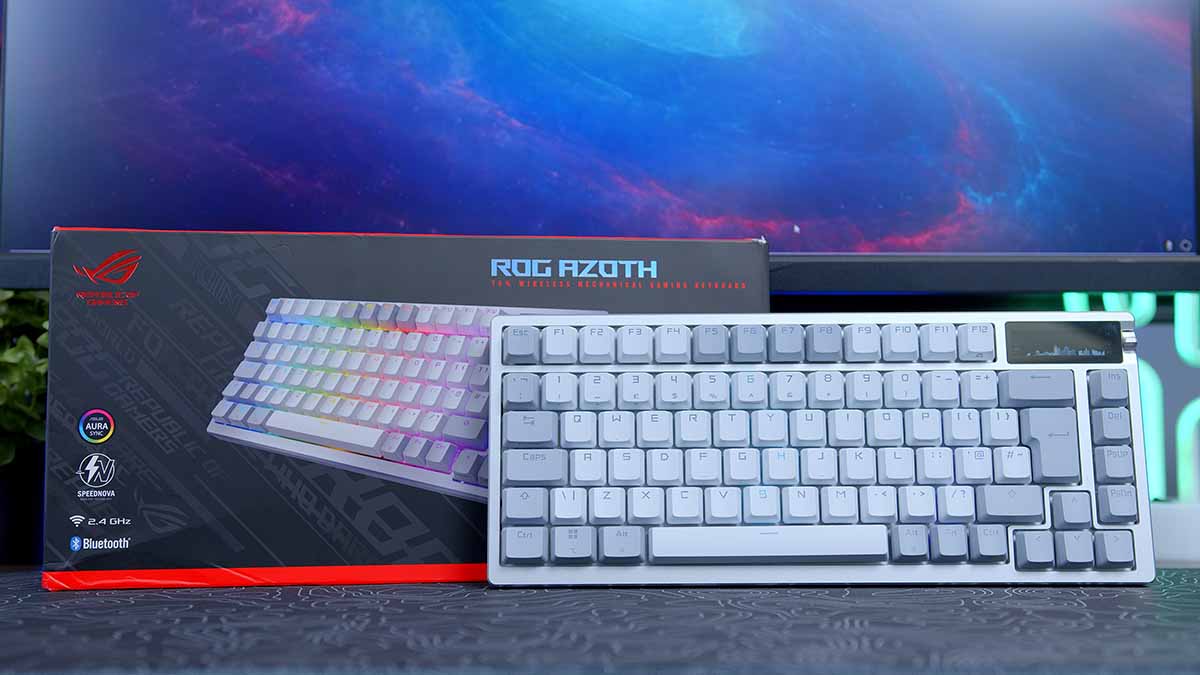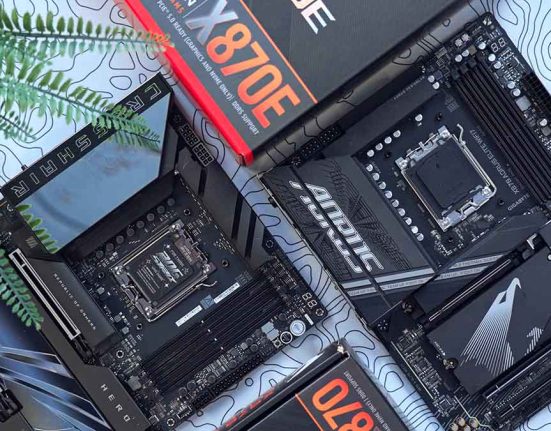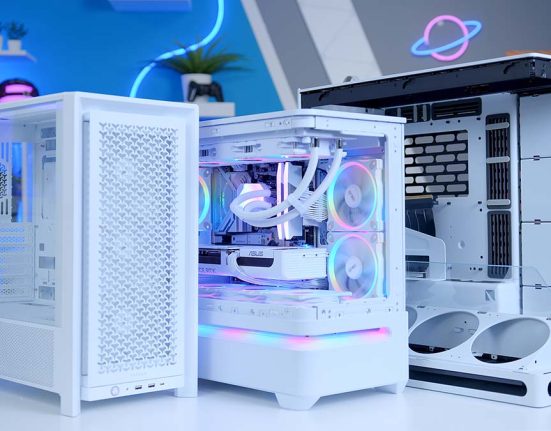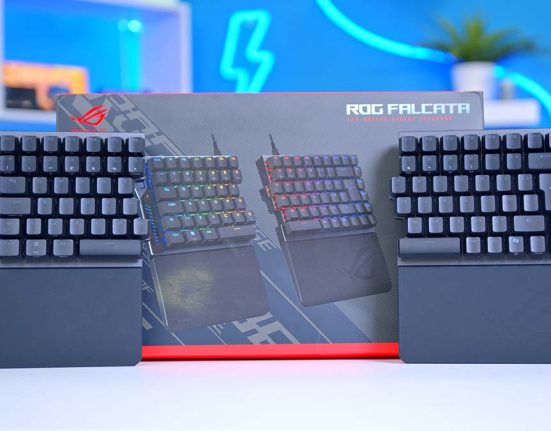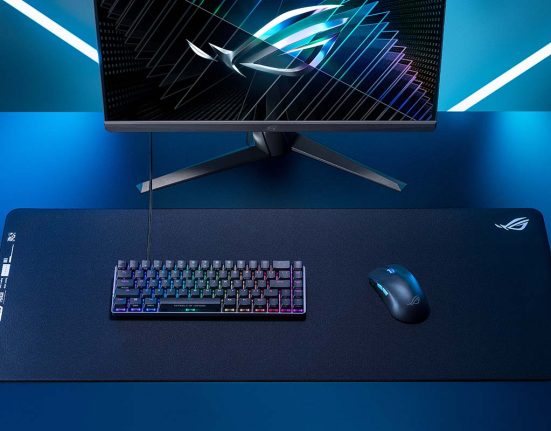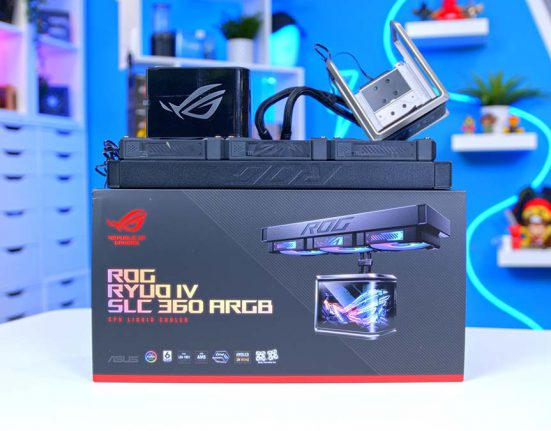Building a custom keyboard that fits your prerequisites can be a daunting experience. With a significant barrier to entry, those without the time to research or put aside a large amount of extra cash, are faced with the harsh reality that building a custom keyboard might not be in the cards.
But what if there was an enthusiast-level keyboard that offers a vast set of awesome features, is fully customisable, and is built for you? This is where the ROG Azoth from ASUS comes in. This gorgeous keyboard offers heaps of customisability, including the ability to change out your switches and keycaps.
In this review we’ll be doing a deep dive on the ROG Azoth, analysing the design, switches and keycaps, along with the various features that this keyboard offers.
Buy the ASUS ROG Azoth on:
ASUS ROG Azoth Design
The ROG Azoth is a hefty, but gorgeous option. The first thing that I noticed about the ROG Azoth, is that it is heavy. Weighing over a kilogram out of the box, there is a significant amount of heft to this keyboard. This is down to the fact that there’s plenty of foam in this case, but the metal top plate also adds to this as well.

In terms of aesthetic, the Moonlight White version of this keyboard is absolutely beautiful. The silvery-grey contrasting tones on the keycaps and the chassis itself looks excellent, and provides some nice depth. I like that this keyboard isn’t fully white, it just brings an alternative look and colour to the table. The RGB lighting also compliments this further, with various colours shining through the legend on the keycaps. I like that ASUS have restricted the RGB purely to the keycaps too, it adds some additional flair without going crazy.


On the rear of the Azoth, you’ll find two different kickstands which provide three levels of adjustment and height options. The kickstands just add a further level of customisation that prioritises the experience of the end-user. Overall, the design of the ROG Azoth is extremely well-rounded and balanced. This keyboard is a bit heavier than I’d like it to be, but this is a small price to pay considering how premium this keyboard feels and looks.
Suggested Article: ASUS ProArt Mouse MD300 Review – Best Wireless Design for Professionals?
ASUS ROG Azoth Keycaps and Switches
While the ROG Azoth does focus on customisation, the switches and keycaps that this keyboard comes with will be ample for most users. The ROG Azoth has a range of different switches that you can choose to utilise, but ASUS kindly sent us the NX Snow variant, which offers linear switches and a set of ROG PBT Doubleshot keycaps.


The keycaps are robust in nature, and feel very solid. Each keycap has a patterned texture, which provides a bit of grip. I do prefer textured keycaps over smooth ones, as they tend to minimise slipping during an intense session of gaming, but they also reduce the amount of visible marks over prolonged usage. The ROG PBT keycaps do feel very premium, and there’s also minimal wobble between each press.
The NX Snow switches are slightly more refined when compared to standard linear switches. The housing used is a POM material, so each keystroke will become smoother over time. The stem of the NX Snow switches are also walled (not too dissimilar from Kailh Box designs). This increases stability, and also prevents any dust from entering your keyboard. It is also worth noting that the NX Snow switches have been pre-lubed, so the typing and gaming experience is very clean and smooth.
While the option to customise your switches and keycaps is rather tantalising, I would be perfectly happy with the choice of switches and keycaps being used straight out of the box.
Features We Like
There are a plethora of features that the ROG Azoth offers. We’ve highlighted our favourites below:
OLED Screen & Control Knob
The OLED screen located towards the top right of the keyboard, is arguably one of the most interesting selling points of this keyboard. The OLED display provides you with system information, or provides some additional flair for your system with some animations. But the best thing about this 2-inch OLED panel and control knob, is that it can control settings of your keyboard, or elements of your computer such as media and volume.

Admittedly, most keyboards have some form of media control, but these tend to be relatively simplistic and are restricted to a combination of key presses. However, the screen and control knob tell you exactly what settings you’re configuring at any given time. The screen can also display more information such as whether ‘Caps Lock’ is enabled, battery life, wireless connectivity, and more. The screen is definitely a ‘wow factor’ of the Azoth, and is quite useful in a range of scenarios.
Tri-Mode Connectivity
Wireless connectivity is the future of gaming peripherals, primarily down to the fact that 2.4GHz and Bluetooth have significantly improved within the past few years or so. Fortunately, the ROG Azoth offers up three different connectivity modes, catering to everyone. If you prefer stability and you’re not bothered by cable mess, you can charge and use the ROG Azoth at the same time.

For those that prefer minimal cabling, or are likely to use the ROG Azoth on the go, this keyboard also offers Bluetooth connectivity, and 2.4GHz wireless. The 2.4GHz wireless mode will be ideal for those playing competitive games, as this connection option offers minimal latency and provides better power efficiency. It is worth noting that Bluetooth connectivity allows you to connect up to 3 devices at the same time, which is awesome.
Finely Tuned Acoustics
A custom keyboard with bad acoustics can be a nightmare. It isn’t a particularly pleasant experience, typing on a keyboard that echoes all of the high pitched ‘pings’ and ‘scratches’ of your switches actuating. When it comes to noise levels and acoustics, you don’t need to worry about the ROG Azoth, because ASUS have gone to some effort here to minimise any annoying sounds that might come from your keyboard as you type away.

The ROG Azoth offers silicon gasket mounting, cushioning your keystrokes as you push down each switch. This is further complimented by the mass of foam mods situated throughout the chassis filling out the case, and further reducing noise levels. Needless to say, the ROG Azoth is a rather quiet keyboard and offers an extremely smooth typing experience.
Battery Life
Despite the Azoth being a very feature-heavy keyboard, the overall battery life is very impressive. According to ASUS, using the 2.4GHz connectivity after a full charge, you’ll be able to get over 2000 hours of gameplay. This will involve you switching off the OLED and RGB, but even with these turned on you’re getting about 3 days of charge.

Features We Don’t Like
Software Experience
While attempting to customise some of the ROG Azoth settings, the software did pose some issues. A reinstallation of Armoury Crate software ironed out a number of these compatibility issues but we found that it did still struggle with device recognition within the software at times. For the most part Armoury Crate acts as a solid and more importantly, useful offering, but we would hope and expect ASUS to fix the issues we experienced in future software versions.
Customising the ROG Azoth – Some Important Things to Know
While the ROG Azoth is perfectly adequate as a fully built keyboard, one of its USPs, is the fact that you can swap out the switches and keycaps for some of your own. This provides an entirely set of options for those of you who like tinkering with different designs. There are some important factors to consider before choosing switches and keycaps. Firstly, compatibility.

While keycaps are relatively universal, switches are not because these depend on the PCB of the keyboard. Fortunately, the ROG Azoth utilises 3-pin Cherry style hot-swappable switches. Box-style switches are highly recommended for this particular keyboard, as the outer housing provides more stability when pressing down the keys.
The ROG Azoth does come with a kit to take your switches apart, and this can be particularly useful if they haven’t been pre-lubed. If you have decided to swap out your switches and you’re looking to lube them, there’s some points to take note of. As a general rule, less is more. You have to be careful when lubing your switches, because too much Krytox could actually cause the switches to stick. So just make sure you aren’t too leisurely with your lubing.
Next is installation. While I do understand the excitement of getting the switches plugged into your keyboard, I would advise patience. The pins on your switches are very fragile and can easily bend, so we recommend lining up your switch beforehand, and then applying even pressure until the switch clicks into place.
Conclusion
ASUS ROG Azoth

Product Name: ROG Azoth
Brand: ASUS
-
Features
-
Design
-
Versatility
-
Value For Money
Summary
ASUS’ ROG Azoth keyboard has impressed me, and is an option that I’d recommend to anyone that is willing to spend the money. The ROG Azoth is versatile, offers a huge amount of customisability, and puts a massive focus on the experience of the end-user. Straight out of the box, this hefty and gorgeous looking keyboard offers up a robust design. The keycaps and switches provide a smooth and quiet feel, which contributes to an overall very consistent and quiet experience. The OLED panel is extremely useful, providing you with real-time system information, or allowing you to control media and RGB lighting. And not to mention, the battery life is exceptional.
My only major qualm currently is the software implementation, whilst not a direct flaw of the Azoth itself, we found the Azoth to fall victim to software issues and dependencies at times. We expect that ASUS will rectify the issues we found with software updates in the future, thus improving the usability and overall experience. For those looking for an enthusiast-level keyboard, the Azoth is definitely worth a look. If you are looking to enjoy the throes of building a keyboard, but without time it takes to research building one from scratch, the ROG Azoth is perfect.
Pros
✅ Looks gorgeous
✅ Great feel, low noise levels
✅ Prioritises user experience
Cons
❌ Software experience
❌ Expensive
❌ Weighty


